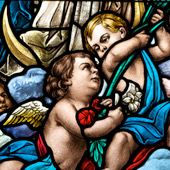What are Sacred Dramas?

Sacred dramas are reenactments of biblical stories but are different from from liturgical dramas that are specific to sacred rites of worship. For example a key element of the Catholic Mass is the liturgical drama of the passion of Christ.
In the Middle Ages, tropes, or expressive verbal presentations of liturgical texts, evolved into more complex and popular dramas that featured important Christian events, including the Christmas season nativity of Jesus and the Easter-time portrayals of His passion and Resurrection.
Over the next 500 years, these early, simple sacred dramas evolved beyond Church presentations to become the historically renowned, European-based mystery plays. These religious dramas were written in a popular poetic vernacular style, versus the Latin Scripture texts of sacred dramas, and could include comedic and highly stylized characters.
Whole towns and guilds were frequently engaged in creating elaborate theatrical productions of biblical stories, often with special effects. In some places, theatrically designed wagons, called pageants, toured towns with professional and amateur actors presenting plays with Christian themes. By the 13th century, miracle plays that portrayed the spiritual gifts and the heroic lives of the saints, were also popularized.
The mystery and miracle plays were suppressed during the time of the Reformation. However, modern revivals were staged in the mid-20th and now in the early-21st centuries.
The Sorrowful Mysteries:
The Agony in the Garden
Aria – Mary
O Earth, Earth, Earth,
hear the Word of the Lord.
(Jer 22:29)



